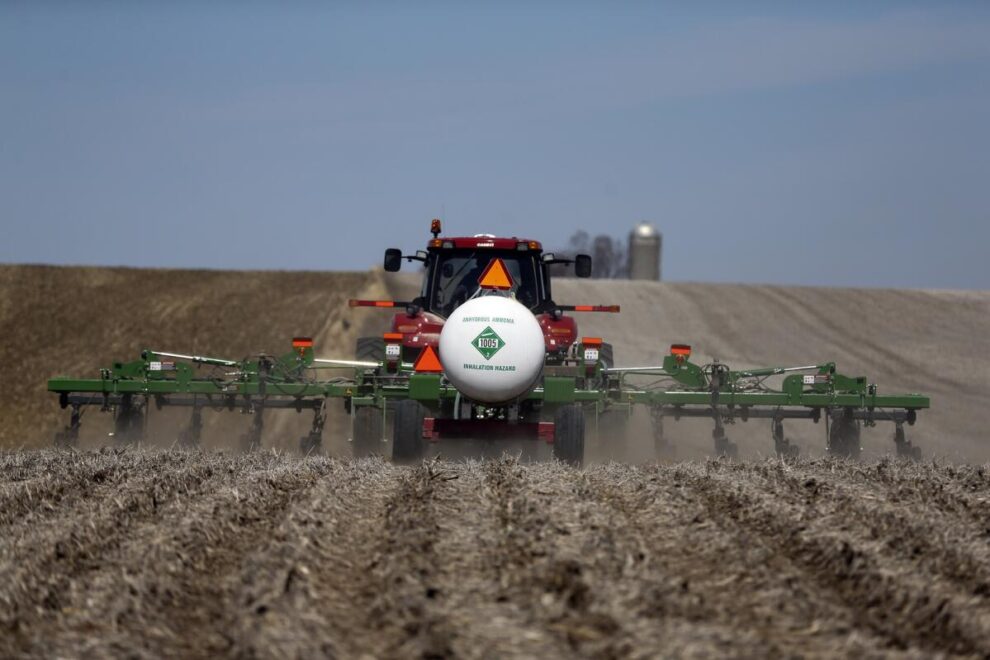Fears of a wet spring may cause farmers to apply more fertilizer now
Iowa farmers last year continued to apply more fertilizer in the fall than in the spring — likely because of volatile weather — but experts say it’s a bad trend for water quality.
“Farmers have been worried we’ve seen some wetter springs delaying chances for spring field work,” said Chad Hart, an Iowa State University economics professor and crop markets specialist. “If they are worried about that, they’ll make that move (fertilizer application) in the fall.”
Iowa farmers bought 4.94 million metric tons of fertilizer from July 1, 2022, through June 30, down 6 percent from the previous year, but 10 percent higher than the 10-year average of 4.49 million metric tons, according to sales data reported by the Iowa Department of Agriculture and Land Stewardship.
Because most farmers don’t have space to store extra fertilizer, they will apply it soon after buying.
For the second year in a row, Iowa farmers applied more commercial fertilizer in the fall than the spring, reversing an eight-year trend of more spring application. The breakdown for 2023 was 55 percent applied in the fall, 45 percent in the spring.
Most farm fields don’t have crops in October or November, so fertilizer applied then has a greater risk of leeching into groundwater or washing into streams before spring planting.
“You lose more when you apply in the fall than you do in the spring,” said Chris Jones, a retired University of Iowa research engineer who writes and teaches about water quality. “We want to time our nutrient inputs to when the crops need it as much as possible.”
Nitrate in drinking water has been linked to infant methemoglobinemia, or blue baby syndrome, and some types of cancer. About 7 percent of Iowans rely on private wells, and more than 6,000 wells had nitrate levels higher than the safe drinking water standard in tests between 2002 and 2017, the Iowa Environmental Council reported in 2019.
High levels of nitrate in the Des Moines and Raccoon river in 2022 caused the Des Moines Waterworks to fire up its nitrate-removal facility, which costs up to $10,000 a day, to produce safe drinking water.
Fertilizers — both commercial and manure — provide crops with nutrients that include nitrogen, phosphorus and potassium that help the crops grow bigger and faster.
The spike in fertilizer sales in 2022 was due to a large amount of potash being applied in fall 2021, Hart said. Potash, which provides potassium needed by corn and soybeans, is often applied every third year.
“The other thing I’m watching here is ‘Do we see them shifting the form of nitrogen they use?’,” Hart said.
Comparing 2022 and 2023, farmers seemed to move slightly from buying anhydrous ammonia to Urea Ammonium Nitrate (UAN), a liquid that also provides nitrogen, but at a cheaper price point, he said.
The big fertilizer story in 2022 was about skyrocketing prices caused by the Russian war in Ukraine.
OCI NV, which owns the Iowa Fertilizer Company in Southeast Iowa’s Wever, reported $6.3 billion in revenue in 2021, up 82 percent from $3.47 billion in 2020. Mosaic Co., one of the nation’s largest fertilizer companies, saw its net income rise 484 percent from 2018-2019 to 2020-2021.
Prices have come down some this year, Hart said.
“You’re talking about anhydrous selling for $650-$700 a ton. At its highest, it was more than double that,” he said. “Compared to history, these are still elevated prices.”
Incentives for spring fertilizer
The U.S. Department of Agriculture last fall updated crop insurance options with an endorsement to encourage spring fertilizer application. This add-on covers potential yield loss if farmers forego fall application, but aren’t able to get in spring application because of wet weather.
The USDA sold only 57 policies covering 9,000 acres, Hart said.
He said it’s possible the 2023 Farm Bill could further incentivize spring fertilizer use, but he doesn’t see that happening because of delays in negotiations in Congress as the possibility of a government shutdown looms.
Source : The Gazatte






































